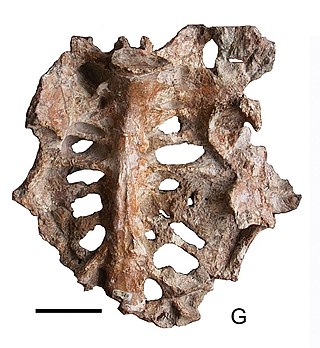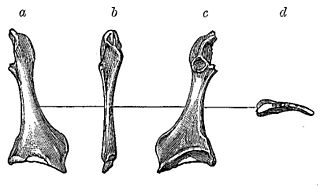
Meniscoessus is a genus of extinct multituberculates from the Upper Cretaceous Period that lived in North America.

The Late Cretaceous is the younger of two epochs into which the Cretaceous Period is divided in the geologic time scale. Rock strata from this epoch form the Upper Cretaceous Series. The Cretaceous is named after creta, the Latin word for the white limestone known as chalk. The chalk of northern France and the white cliffs of south-eastern England date from the Cretaceous Period.

Alamosaurus is a genus of titanosaurian sauropod dinosaurs containing a single known species, Alamosaurus sanjuanensis, from the Maastrichtian age of the Late Cretaceous period in what is now southwestern North America. It is the only known titanosaur to have inhabited North America after the nearly 30-million year absence of sauropods from the North American fossil record and probably represents an immigrant from South America.

Gargantuavis is an extinct genus of large, primitive bird containing the single species Gargantuavis philoinos. It is the only member of the monotypic family Gargantuaviidae. Its fossils were discovered in several formations dating to 73.5 and 71.5 million years ago in what is now northern Spain, Southern France, and Romania. Gargantuavis is the largest known bird of the Mesozoic, a size ranging between the cassowary and the ostrich, and a mass of 141 kg (311 lb) like modern ostriches, exemplifying the extinction of non-avian dinosaurs wasn't a necessary condition for the emergence of giant terrestrial birds. It was once thought to be closely related to modern birds, but the 2019 discovery of a pelvis identified as cf. Elopteryx nopcsai from what was Hațeg Island shows several primitive features.

Cimolopteryx is a prehistoric bird genus from the Late Cretaceous Period. It is currently thought to contain only a single species, Cimolopteryx rara. The only specimen confidently attributed to C. rara was found in the Lance Formation of Wyoming, dating to the end of the Maastrichtian age, which ended about 66 million years ago. The dubious species "Cimolopteryx" maxima has been described from both the Lance Formation and the Hell Creek Formation of Montana. The humeral end of a left coracoid from the Frenchman Formation of southern Saskatchewan has also been attributed to the genus.
Congorhynchus is an enigmatic, likely polyphyletic genus of prehistoric marine ray-finned fish that was described by E. Darteville and E. Casier in 1949.

Gasteroclupea is a genus of prehistoric ellimmichthyiform fish that is distantly related to modern anchovies and herrings. It contains one species, G. branisai. It inhabited freshwater or estuarine habitats across South America during the Campanian and Maastrichtian stages of the Late Cretaceous period, and it briefly survived beyond the K-Pg boundary into the Danian stage of the Paleocene, making it among the few genera from its order to survive into the Cenozoic. Fossils of the genus have been found in the Yacoraite Formation of Argentina, the Chaunaca Formation, Santa Lucía Formation, and El Molino Formation of Bolivia, and the Navay Formation in Venezuela.

Coriops is an extinct genus of freshwater osteoglossomorph fish, possibly a hiodontiform, with a single species known from the Late Cretaceous of western North America.
Pucabatis is a prehistoric genus of ray whose fossils are found in rocks dating from the Maastrichtian stage. The type and only species is P. hoffstetteri. Fossils of Pucabatis have been found in the El Molino Formation of Bolivia and the Bagua Formation of Peru.

The Maastricht Formation, named after the city of Maastricht in the Netherlands, is a geological formation in the Netherlands and Belgium whose strata date back to the Late Cretaceous, within 500,000 years of the Cretaceous–Paleogene boundary, now dated at 66 million years ago. The formation is part of the Chalk Group and is between 30 and 90 metres thick. It crops out in southern parts of Dutch and Belgian Limburg and adjacent areas in Germany. It can be found in the subsurface of northern Belgium and southeastern Netherlands, especially in the Campine Basin and Roer Valley Graben. Dinosaur remains are among the fossils that have been recovered from the formation.
The Lopez de Bertodano Formation is a geological formation in the James Ross archipelago of the Antarctic Peninsula. The strata date from the end of the Late Cretaceous to the Danian stage of the lower Paleocene, from about 70 to 65.5 million years ago, straddling the Cretaceous-Paleogene boundary.

Anomoeodus is an extinct genus of prehistoric marine ray-finned fish belonging to the family Pycnodontidae. This genus primarily lived during the mid-to-late Cretaceous period, ranging from the Albian to the very end of the Maastrichtian age, and possibly into the Danian. The first fossils of Anomoeodus were described by Louis Agassiz in 1833, although they were described under Pycnodus. Some studies have recovered it as a wastebasket taxon.
Egertonia is an extinct genus of prehistoric marine and estuarine ray-finned fish known from the Late Cretaceous to the middle Eocene. It contains one known species, E. isodonta, although indeterminate remains potentially referable to other species are also known. It was a member of the Phyllodontidae, an extinct family of elopomorph fish with crushing tooth plates, which are the primary remains found of the genus.

The Ojo Alamo Formation is a geologic formation in New Mexico spanning the Mesozoic/Cenozoic boundary. Non-avian dinosaur fossils have controversially been identified in beds of this formation dating from after the Cretaceous–Paleogene extinction event, but these have been explained as either misidentification of the beds in question or as reworked fossils, fossils eroded from older beds and redeposited in the younger beds.
The Hornerstown Formation is a latest Cretaceous to early Paleocene-aged geologic formation in New Jersey. It preserves a variety of fossil remains, including those of dinosaurs, and contains direct evidence of the mass mortality that occurred at the Cretaceous-Paleogene boundary.
Socognathus is a genus of prehistoric chamopsiid polyglyphanodontian lizards containing species that lived from the Middle Campanian stage to the late Maastrichtian. Several specimens of the type species, Socognathus unicuspis, have been found in Alberta, Canada. A second species, Socognathus brachyodon is known from the late Maastrichtian Lance Formation; its fossils have been found in Wyoming, United States.

Augustynolophus is an extinct genus of herbivorous saurolophine hadrosaur dinosaur which was discovered in the Moreno Formation in California, dating to the late Maastrichtian age, making it one of the last dinosaurs known from the fossil record before the Cretaceous–Paleogene extinction event.

The Cretaceous–Paleogene (K–Pg) extinction event, also known as the K–T extinction, was the mass extinction of three-quarters of the plant and animal species on Earth approximately 66 million years ago. The event caused the extinction of all non-avian dinosaurs. Most other tetrapods weighing more than 25 kg (55 lb) also became extinct, with the exception of some ectothermic species such as sea turtles and crocodilians. It marked the end of the Cretaceous period, and with it the Mesozoic era, while heralding the beginning of the current era, the Cenozoic. In the geologic record, the K–Pg event is marked by a thin layer of sediment called the K–Pg boundary, Fatkito boundary or K–T boundary, which can be found throughout the world in marine and terrestrial rocks. The boundary clay shows unusually high levels of the metal iridium, which is more common in asteroids than in the Earth's crust.

Alcione is a genus of pterosaur from the Ouled Abdoun Basin of Morocco, dating back to the Maastrichtian stage of the Late Cretaceous period. Only one species, A. elainus, is known. This pterosaur lived in a marine environment alongside several other pterosaurs, including Simurghia and Barbaridactylus.

The Kristianstad Basin is a Cretaceous-age structural basin and geological formation in northeastern Skåne, the southernmost province of Sweden. The basin extends from Hanöbukten, a bay in the Baltic Sea, in the east to the town of Hässleholm in the west and ends with the two horsts Linderödsåsen and Nävlingeåsen in the south. The basin's northern boundary is more diffuse and there are several outlying portions of Cretaceous-age sediments. During the Cretaceous, the region was a shallow subtropical to temperate inland sea and archipelago.














